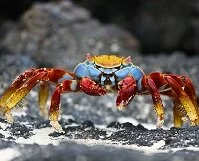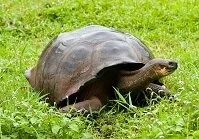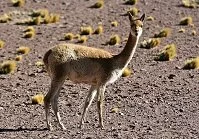Wildlife

Red rock crab
Ecuador has a fairly diverse variety of wildlife as the mainland is very mountainous and wooded, but also has lowlands along the coast. Additionally, the off shore Galapagos Islands are famed for being some of the most diverse and unique islands in the world when it comes to wildlife and is home to the famed Galapagos Turtle as well as dozens of species of finches and other bird species, which helped lead Charles Darwin to his theory of natural selection.
Many of the more common mammals are woodland animals, such as squirrels, mice, rats, bats, opossums, deer, rabbits, tapirs, sloths, and others. However, the mountains and rain forests attract these animals as well as others, including llamas, alpacas, vicunas (a camel species), cougars (puma), beers, armadillos, porcupines, monkeys, jaguars, and wolves. There are also some rodents unique to South America in Ecuador, such as the chinchilla.
Ecuador also has a huge variety of sea life in the Pacific Ocean. The ocean is home to mammals, like whales and dolphins, as well as fish and shellfish. Among these sea dwellers are sharks, tuna, mahi-mahi, snapper, mackerel, grouper, puffer fish, shrimp, crabs, seahorses, starfish, eels, rays, jellyfish, and sea urchins.

Galapagos Turtle
The bird life is almost as diverse as the sea life. Among these are egrets, eagles, condors, partridges, coots, geese, sandpipers, ibis, herons, finches, hummingbirds, wrens, owls, sparrows, cardinals, jays, orioles, frigate birds, pigeons, parakeets, flamingos, and woodpeckers. The Galapagos Islands are home to dozens of unique species, including dozens of bird species that are closely related.
The reptilian, amphibian, and insect life in Ecuador are also diverse, but the variety of species is still fairly limited. On the mainland many of these animals are spiders, including the tarantula and black widow, and snakes, including the rattlesnake. In or near some of the rivers the amphibian population spikes as a number of frogs, iguanas, and lizards are present. The Galapagos Islands are again home to numerous species and is well known for their turtle populations. The number of insects is quite substantial, including flies, mosquitos, butterflies, ants, and more.

Vicuna
When it comes to native plant life, South America is home to many famous edible plants and these plants quickly spread throughout Ecuador, South America, and beyond. The pineapple is from the region where Brazil and Uruguay meet while potatoes and tobacco originated in the Andes Mountains. A few others, including cacao trees (used to make chocolate), peanuts, and tomatoes are also from South America, although their actual origin is unknown. Peppers, both sweet and hot peppers are from Central America or northern South America while vanilla, avocado, papaya, and corn (maize) are likely from Central America itself. No matter each food's origin, what is known is that these foods spread throughout the continent and to the country of Ecuador with the help of pre-historic people, animals, and winds. These people have had these foods for nearly as long as people have inhabited the region and each makes an important part of the people's diet and culture now and for thousands of years into the past.
Other plants are also present in Ecuador. Orchids, lilies, rosewood trees, mahogany trees, mangrove trees, rubber trees, walnut trees, cedar trees, oak trees, and thousands of other trees, flowers, ferns, and plants can be found in Ecuador.